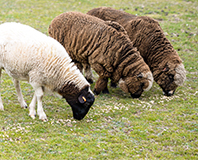Read the latest information on
Foot-and-mouth disease
 Aussie farmers are no strangers to a dry spell. As a largely arid country, seasonal conditions can make or break a business. However all the planning and experience in the world cannot substitute for rainfall, and as drought conditions continue through large parts of the country, feed supplies are alarmingly low, leading livestock producers to source what they can, where they can.
Aussie farmers are no strangers to a dry spell. As a largely arid country, seasonal conditions can make or break a business. However all the planning and experience in the world cannot substitute for rainfall, and as drought conditions continue through large parts of the country, feed supplies are alarmingly low, leading livestock producers to source what they can, where they can.
Feed is a crucial farm input – that is, something you bring on to the property to assist production – however any purchase of feed risks bringing in diseases, pests and weeds from beyond your property. Thankfully, like many biosecurity risks, the introduction of outside feed can be managed in a few simple steps.
Firstly, always request a Commodity Vendor Declaration when purchasing feed or fodder. This document gives you an insight into the source of the product and its integrity, allowing you to make informed decisions about how you manage its use. This is important for meeting your food safety obligations, as feed and fodder may have been treated with or exposed to chemicals and still be in the withholding period.
Ensure that feed containing restricted animal material or RAM, i.e. any material taken from a vertebrate animal, other than tallow, gelatin, milk products or oils, is not made available to ruminants, such as cattle, sheep, goats or deer. Feeding RAM to ruminants is illegal under state and territory laws to prevent the risk of diseases such as bovine spongiform encephalopathy (BSE), commonly known as ‘mad cow disease’. Feeds containing RAM are required to be clearly labelled as such, and the presence of RAM is a question on the Commodity Vendor Declaration.
Conduct a visual inspection of any feed upon delivery to ensure it is not contaminated and does not contain weed seeds. A visual inspection should be standard procedure for all inputs entering the property. Once your purchased feed has passed inspection, feed it out in a single area and confine livestock to this paddock for a reasonable length of time. Monitor the paddock in question for signs of new weeds, which may have come in through the feed and been dispersed by your stock.
It’s important to be aware of any restrictions in place in your state regarding the movement of feed and fodder before making any purchases, especially when your purchase is being sourced from interstate. Your state department of agriculture or primary industries may have policies and procedures in place to prevent the introduction or spread of significant diseases, pests or weeds, which may include restrictions on hay, grain, fruits and vegetables crossing the border.
Lastly, should the situation force you to seek agistment for your stock due to a lack of available feed, ensure that animals are accompanied by the appropriate movement documentation, that the NLIS database is updated and that each animal loaded is fit to travel. On their return, follow an appropriate reintroduction procedure, as you would for any new or returning animals entering the property.
Following these few simple steps as part of your everyday farm management strategy will help to ensure that risk of diseases, pests and weeds affecting your enterprise is kept low throughout the drought and into the recovery phase. For more information on managing farm inputs, see the essentials page on the Farm Biosecurity website.